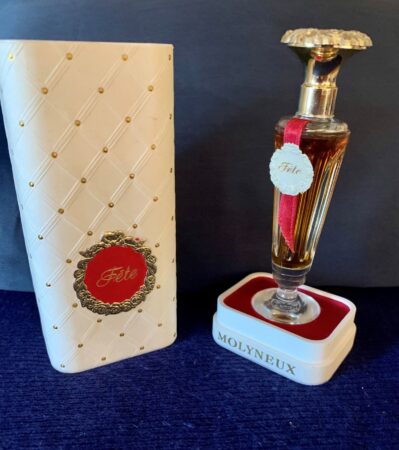
Fête de Molyneux by Ida ©
It often happens that I ferret about in my perfume collection (some of which spans over 50 years) and unearth a neglected treasure – perhaps one with which you, dear readers – may be unfamiliar. Such was the case a few weeks ago when I chanced upon my beautiful flacon of Fête de Molyneux parfum – one of the Grande Dames of perfume past and present. It elicited a deep sigh from me, and my husband (pressed into service) was immediately ensorcelled, which is not a frequent occurrence. Fête simply pleaded with me to review it – and I tend to follow my nose’s bidding.
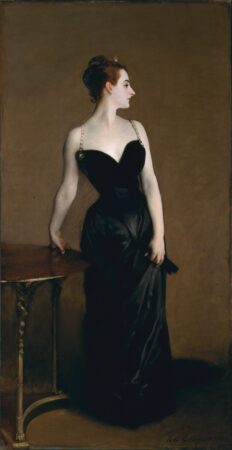
Portrait of Madame X (Madame Gautreau) 1884 by John Singer Sargent
I’m aware that vintage perfumes aren’t everyone’s cup of tea: obtaining them can be a crap shoot, unless you have a good relationship with the seller and know for certain that they have been carefully stored and are in reasonable condition. Some are rare as hen’s teeth, so they are likely to be very costly; more often than not, the top notes may be either greatly altered or have disappeared entirely – due to evaporation, contamination, exposure to air, light, varying temperatures, or gradual degradation over time. Some view vintages as waste of time; they are more interested in what is currently available on the market, or have little interest in the historical aspect of fragrance – or they fear falling in love with something which they cannot afford or find, which is completely understandable. For my part, I confess a weakness for mystery, intrigue, and history, and I’m older than our readers in general – so what seems vintage or outdated to them is catnip to me. I remember when many were released; that’s how long I’ve been obsessed with aroma and perfume. I crave the experience of the twists and turns of vintage fragrance, the journey it takes, the subtle entanglements of intrigue and seduction which develop upon a fleshly canvas as you wear it.
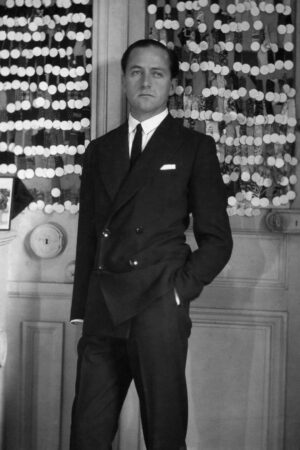
Getty ©Edward Molyneux
The house of Molyneux has provided us with some brilliant perfumes: the sparkling aldehydic Vivre (1971, revamped in 2017), elegant Quartz (1977), the aldehydic floral chypre Numero Cinq (1925), and the delicious Gauloise (1980) amongst them. It all began with British couturier Edward Molyneux, who designed such beautiful gowns that even Christian Dior and Pierre Balmain admired them, and Hollywood luminaries Vivien Leigh, Greta Garbo, and Gertrude Lawrence sought Molyneux’s expertise. His fashion atelier moved back and forth between London and Paris, due to WW II. In 2014, Berdoues (Violettes de Toulouse) purchased Molyneux and continues to produce some of their perfumes (which have changed a great deal); sadly, Fête is not amongst them. I proffer the thought that some of the materials which made Fête glorious are either no longer used or acceptable by IFRA standards.
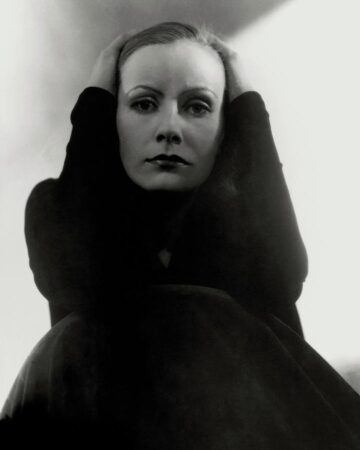
Steichen portrait of Greta Garbo in Molyneux’s famous black dress via Conde Nast
Molyneux has employed a variety of perfumers over the years, and it was challenging to verify the nose for Fête. I literally had to download all the perfumes listed in the annals of Versaille’s famous Osmothèque in order to locate a reputable source. I have been unable to uncover any photos of perfumer Suzanne Mabereau, much less information – so she remains an enigma to me; I’m nonetheless grateful for her Fête de Molyneux.
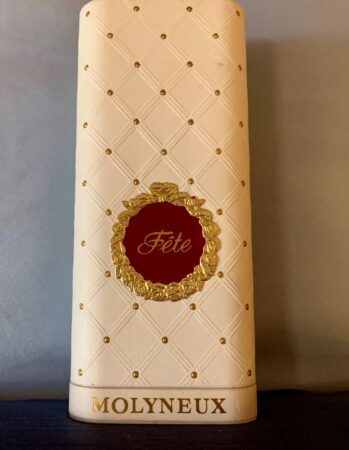
Ida’s photo of the box Fête de Molyneux
When you open a bottle of Fête de Molyneux, you will undoubtedly smell the lineage of the two great perfumes which preceded it: Guerlain’s legendary 1919 Mitsouko (Jacques Guerlain), and 1944’s magnificent Femme (Edmond Roudnitska). Both perfumes were created at a time when perfume regulation was minimal and voluptuousness reigned supreme; fruity chypres were full-bodied, and women donned floral animalic fragrances with gusto. Molyneux’s creation is every bit as oakmossy and fruity as both Femme and Mitsouko, and they all three share iris, jasmine, ylang-ylang, and citrus notes. Each is spicy, but unique: Femme and Mitsouko are cinnamony, while Fête employs caraway, with its intensely warm, spicy/woody nature – and is as leathery as Femme. A mere glance at Fête and Femme side-by-side reveals a very similar roster of top notes, and both smell animalic (Mitsouko does not); Femme’s 2013 revision by Olivier Cresp lists cumin, and while Molyneux does not list it, we smell it nonetheless. Fête augments its dangerous side with civet, which adds a sweet and potent skanky tone to its base that neither of the others possess. I think you can see what I’m getting at: three masterpieces which share many points of convergence, yet each emerges individually as its own fragrant entity.
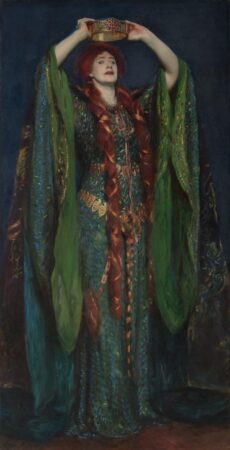
Tate Gallery portrait of Ellen Terry as Lady Macbeth by Sargent 906
When I apply Fête de Molyneux, I am transported to the days of grandes horizontales: women who rose to positions of power and influence emerging from humble (and often unsavory) origins. I imagine the seductive, imperious portraits painted by John Singer Sargent – like his awe-inspiring portrait of actress Dame Ellen Terry as mythical Lady Macbeth. A worldly sultriness, uninhibited and perhaps as licentious as Sargent’s portrait of Betty Wertheimer. There is something splendidly erotic about this perfume which is manifested with finesse: as ripe as the ripest peach and plum, as indolic and bewitching as its blooms and civet cat. Deep as a well and somehow as comfortable and comforting as a scent can be. Fête may suggest such decadent images for me, but that doesn’t mean that its appeal is limited to the past; anywhere there are charismatic people, it awaits. And it’s divine on daring men as well.
Notes: caraway, plum, peach, bergamot, Brazilian rosewood, lilac, orris root, jasmine, ylang-ylang, sandalwood, benzoin, vanilla, oakmoss, civet, leather. (Perceived notes: aldehydes, patchouli, cumin)
Fête de Molyneux perfume is from my collection. My nose is my own…
~ Ida Meister, Senior Editor and Natural Perfumery Editor
Follow us on Instagram @cafleurebonofficial and idameister
This is our Privacy and Draw Rules Policy
